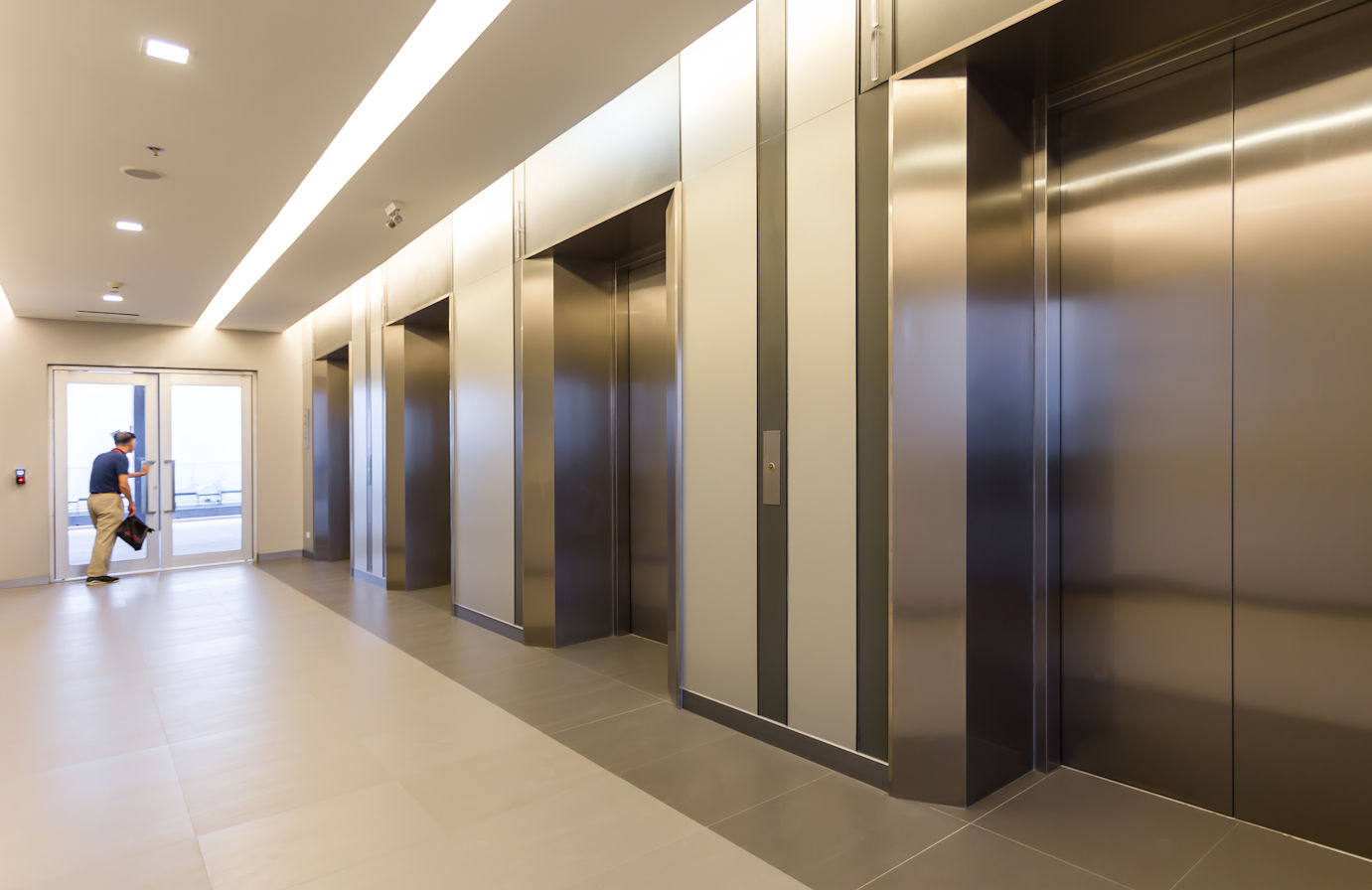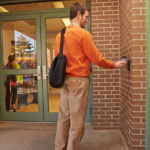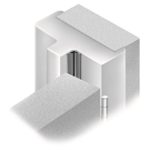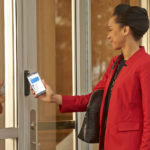 Security at elevator lobbies can be difficult to facilitate, and the model codes handle this application in two different ways, adding to the confusion. If we imagine a tenant space in high-rise building, there is typically a desire to prevent access from an elevator lobby to the office suite after hours. On the other hand, building occupants who may be in the elevator lobby need a path of egress; in most cases, the elevators do not qualify.
Security at elevator lobbies can be difficult to facilitate, and the model codes handle this application in two different ways, adding to the confusion. If we imagine a tenant space in high-rise building, there is typically a desire to prevent access from an elevator lobby to the office suite after hours. On the other hand, building occupants who may be in the elevator lobby need a path of egress; in most cases, the elevators do not qualify.
Some elevator lobbies have direct access to a stairwell, which would typically serve as the means of egress, but in many buildings, people may have to leave the elevator lobby to find an exit stairwell. This creates a conflict between security for the tenant space, and egress for the elevator lobby.
NFPA 101
For many years, NFPA 101 – Life Safety Code, has included a section that allows elevator lobby doors to be electrically locked if certain criteria are met. In the 2021 edition, this section is 7.2.1.6.4 – Elevator Lobby Exit Access Door Assemblies Locking. This section mandates the following:
- This application must be permitted by the occupancy chapter applicable to the building.
- Electrified hardware used on these door openings must be listed in accordance with UL 294 – Standard for Access Control System Units.
- The building must be protected throughout by an approved, supervised automatic sprinkler system, and waterflow in the sprinkler system must initiate the building fire alarm system.
- The elevator lobby must be protected by an approved, supervised smoke detection system, and detection of smoke must initiate the fire alarm system and notify building occupants.
- Initiation of the building fire alarm system by a means other than manual fire alarm boxes must unlock the electrified lock on the elevator lobby door.
- The electrified lock on the elevator lobby door must unlock upon loss of power to the electrical locking system.
- After being unlocked, the door must remain unlocked until the fire alarm system has been manually reset.
- If the door remains latched after it is electrically unlocked, the hardware to release the latch must be mounted on the door.
- A two-way communication system is required, which will allow communication between the elevator lobby and a central control point that must be constantly staffed by people who are capable, trained, and authorized to provide emergency assistance.
I-Codes
 Current and past editions of the International Building Code (IBC) do not include a section similar to the one found in NFPA 101. The IBC states: “Elevator lobbies shall be provided with not less than one means of egress complying with Chapter 10 and other provisions in this code.” In practice, this means that when an elevator lobby does not have direct access to an exit stairwell, the elevator lobby door must allow egress in a way that is code-compliant. The door could allow free egress out of the elevator lobby, or be equipped with an exit alarm to deter egress. In some use groups, a delayed egress lock could be used, but that is the most restrictive application that would be allowed by the IBC. After 15 seconds, the delayed egress lock would allow access to the tenant space.
Current and past editions of the International Building Code (IBC) do not include a section similar to the one found in NFPA 101. The IBC states: “Elevator lobbies shall be provided with not less than one means of egress complying with Chapter 10 and other provisions in this code.” In practice, this means that when an elevator lobby does not have direct access to an exit stairwell, the elevator lobby door must allow egress in a way that is code-compliant. The door could allow free egress out of the elevator lobby, or be equipped with an exit alarm to deter egress. In some use groups, a delayed egress lock could be used, but that is the most restrictive application that would be allowed by the IBC. After 15 seconds, the delayed egress lock would allow access to the tenant space.
Because of the need for security on these doors, several states and local jurisdictions have modified the IBC to include a section similar to the one found in NFPA 101. These modifications demonstrate the need for a code change addressing elevator lobby doors, to ensure consistency and a balance of life safety and security. The Builders Hardware Manufacturers Association (BHMA) submitted a proposal addressing elevator lobby doors for the 2024 ICC code development cycle (E56-21), which has been approved as modified by a floor modification. The new section will be included in the 2024 IBC, and will be applicable when this edition has been adopted in a project’s jurisdiction. Prior to adoption, the new section could be used as the basis for a code modification request submitted to the AHJ.
According to the 2024 IBC, doors leading from an elevator lobby to a tenant space may be electrically locked, preventing access from the elevator lobby to the tenant space, if the following criteria are met:
- The path of travel for all building occupants to at least two exits must not be required to pass through the elevator lobby.
- The building must be equipped throughout with an automatic sprinkler system and a fire alarm system. The elevator lobby must be provided with an automatic smoke detection system.
- Activation of the fire alarm system must automatically unlock the lock to allow egress from the elevator lobby, and the lock must remain unlocked until the fire alarm system is reset. Activation of the fire alarm system by a manual fire alarm box is not required to unlock the door.
- The electric lock must unlock upon loss of power to the lock or or electrical locking system, and must also have the capability of being unlocked via a switch located at the fire command center, security station or other approved location.
- A two-way communication system must be installed in the elevator lobby adjacent to the door with the electrified hardware. The communication system must be connected to an approved, constantly attended station that has the capability of unlocking the door.
- Emergency lighting must be provided on both sides of the electrically locked door.
- The door locking system units must be listed to UL 294.
Although the IBC requirements are not exactly the same as those of NFPA 101, the model codes will now be more closely aligned on this issue. Egress and life safety for building occupants will be addressed, while maintaining a level of security for tenants.
Any questions?
You need to login or register to bookmark/favorite this content.








Navigating the complexities of security and egress in elevator lobbies has always been a challenge, and your article sheds light on the divergent approaches outlined by NFPA 101 and the I-Codes. It’s intriguing to see the evolution in the 2024 IBC, incorporating changes that acknowledge the delicate balance between life safety and security. The detailed criteria for electrically locking doors, coupled with the two-way communication system and emergency lighting, offer a comprehensive solution.
This shift towards alignment between NFPA 101 and IBC signifies a step forward in ensuring consistency across jurisdictions. Your insights into the BHMA proposal for the 2024 ICC code development cycle highlight the collaborative efforts to address these nuances. The clarity provided here will undoubtedly aid professionals navigating these regulations.
Thanks to the author for demystifying this intricate topic. Your efforts in presenting a digestible yet comprehensive overview are greatly appreciated.
• For similar topics, read this article: https://www.techtopia5.com/2024/01/elevators.html